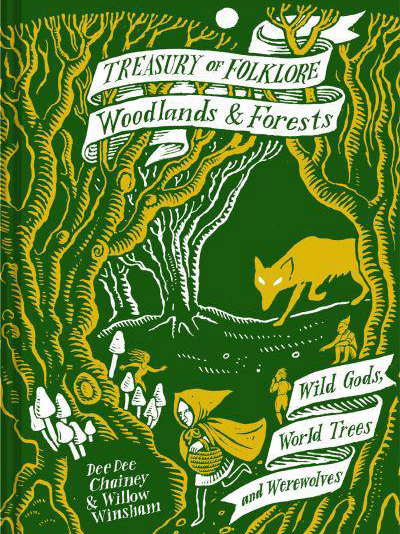From Living Woods issue 61
Writer LAWRENCE ILLSLEY, no stranger to a good story, is drawn into the world of woodland myth and legend

TREASURY OF FOLKLORE: WOODLANDS AND FORESTS
DEE DEE CHAINEY AND WILLOW WINSHAM
Batsford
Hardback
192 pages
£12.99
ISBN 978-1849946872
The Treasury of Folklore: Woodlands and Forests, is a cornucopia of woodland mythology from around the globe, collected and researched by the duo behind the popular Folklore Thursday website, Dee Dee Chainey and Willow Winsham.
My first impressions of the book, pulling it from the envelope, were excellent. The greens and browns of the beautifully illustrated hardback cover felt special, and I immediately wanted to show it off, and place this book on my bookshelf. Not that we should judge a book by its cover, but for this type of collection, which is often bought to keep, design is important. The quality of the cover continues throughout the book with a series of stunning black and white illustrations by Joe McLaren, reminiscent of block printing, accompanying the text at every turn.
So, a positive visual impact, but what about the words? These, again, were a surprise to me. The word ‘treasury’ in the title led me to expect a collection of folk tales, to which I am partial, but I found much more than that. Folk tales do feature, but more as examples. This book is a study, a passionate overview of the variety and form of woodland folk tales found across the globe. It is this research and categorisation that sets the book apart from others of its kind.
The book is split into three parts and covers topics as diverse as the world tree, wolves, dryads and giants, as the authors expertly guide us through the global pantheon of woodland myth and folklore. The book is succinct, whilst being clearly well-researched, and provides a valuable introduction to a vast subject area. The reader can dip in or out or read it cover- to-cover. The style of writing is gentle and conversational, guiding the reader and imparting knowledge without it ever feeling like a lecture. And cleverly, having opened the door, the authors finish the book with a large reference section of further reading for anyone keen to expand their knowledge.
Whilst the book delves back into the history of folklore it also brings these stories and ideas up to date, placing this history into a modern context. The authors address contemporary concerns such as cultural misappropriation and have kept all names in their original language, despite any difficulty this may pose to the reader, a decision I heartily support.
If I am honest my favourite moments are where the authors give us real examples of the tales they discuss, bridging the academic and the storytelling worlds. These stories bring to life the topics the authors are describing. Perhaps my only criticism would be a wish that there were even more folk tales in the book. But then, this would take away from the essence of the work and may muddy what is a remarkably concise and enjoyable read, an essential and permanent addition to any library about trees and a great place to begin an exploration of woodland folklore.